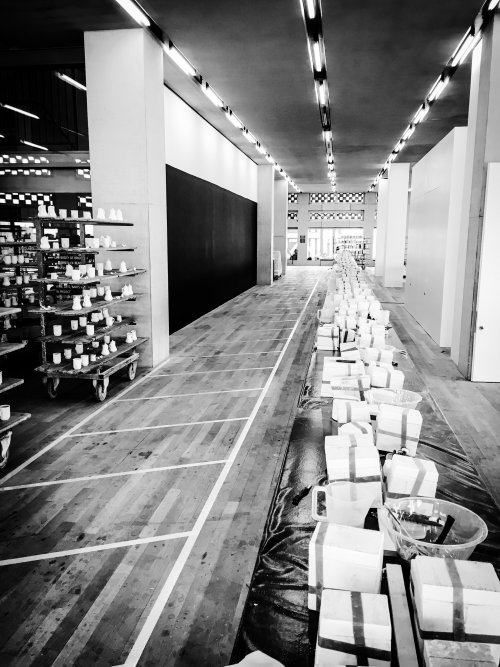Assembly Line Ceramics at Tate Modern
One of the most prestigious and well-known contemporary art museums in the world recently opened its doors to host a functioning ceramics factory. Each year, the Tate Modern in London presents Tate Exchange, a program exploring shared making. This year’s theme is production. With that in mind, the museum reached out to British artist Clare Twomey.
Twomey, known for her large-scale collaborative projects, works primarily in ceramics. Citing clay’s “rich material history and commonality of material connection that allows so many stories to be told,” Twomey makes this versatile, tactile, and accessible material a natural fit for her largely community-based projects. The experience she developed for the Tate Exchange around the theme of production, “Factory: the Seen and the Unseen,” open September 28 – October 8, involved a week-long production-line style ceramics factory – with an invitation for the public to participate – followed by another week of lectures and programs engaging the idea of “collective labor.”

Photo: © Clare Twomey Studio
During the first week, guests were invited to move through the production line: clocking in, pouring slip, trimming excess clay, removing a finished piece from the mold, and finally placing an unfired (but fully designed) jug, cup, or flower onto a wooden rack that made its way to the kiln. The process provided a limited – but interactive – experience with this type of labor, and each visitor could exchange the item they made for a completed piece by someone else.
Twomey used this workshop to explore deeper ideas surrounding shared labor and collaboration in the making process. She acknowledges that while “Factory” is not a “real place of work; it is a place of simulation, with the intent to draw us into a conversation about how we connect to our everyday ideas of labour, value, and exchange.”
When the “active” labor of the production-line was complete, Twomey explored what could be thought of as more “passive” labor during “Redundant Factory,” the programed lectures that took place during the second week. She described “Redundant Factory” as a space “filled with the evidence of the human, but the wholeness of the factory is fractured – a space now exists where the human is craved. The purpose of the factory has become a proposition of both loss and potential. The tasks of labor are now listening, reflecting, observing.”
Throughout this process, Twomey has continually asked questions via Twitter. One of those questions in particular resonates today: “Does the way something is produced affect how you value it?” It’s interesting that this question is posed both here in the specific context of the “Factory,” but versions of it permeate more broadly in today’s art world. While placing a definitive value on contemporary art becomes more and more nebulous and fluid, at the same time craft seems to be continually defined by how it is produced and the materials used – for better or for worse. That difference between how you determine value of art versus craft may be one of the defining tenets in their traditional dichotomy. It’s intriguing too that the Tate Modern, a powerhouse venue of contemporary art, would play host to the literal production of a traditionally craft-based medium and form. In turn, this causes me to wonder how important a space becomes in this type of project, not only physically and demographically, but also in terms of inherent cultural and societal significance.
Learn more about this year’s theme of production.


